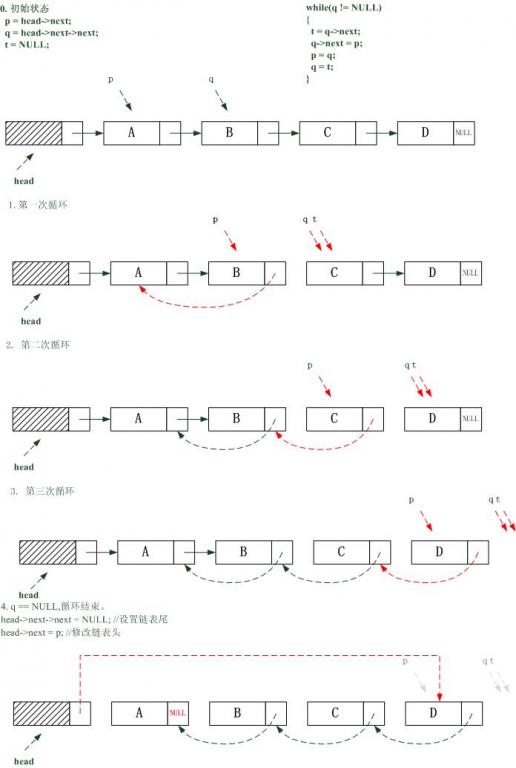#include <stdio.h> #include <stdlib.h> #include <malloc.h> typedef struct ListNode{ int data; struct ListNode *next; }inversList; /*这个函数实现创建链表*/ inversList *createList() { inversList *head=NULL,*a=NULL,*b=NULL; //定义了指针之后最好清空,以免野指针的出现, //比如这里的head如果不设置为null的话,下面的oldList==NULL就会导致系统提示调试错误。。。 while(1) { if(NULL==(b=malloc(sizeof(inversList)))) { printf("内存申请失败"); exit(1); } //为指针b分配内存空间 printf("输入一个数:"); scanf("%d",b); //输入数存入b指向的内存空间 if(0==b->data) break; //直到输入0时,循环结束输入节点 b->next=NULL; //将b的next域设置为空,防止野指针出现 if(NULL==a) { a=b; head=a; } else { a->next=b; a=b; } } return head; } /*这个函数实现链表的反转*/ inversList *invert(inversList *next,inversList *prior) { inversList *head=next; if(NULL!=next->next) { head=invert(next->next,next); } next->next=prior; return head; } int main(void){ inversList *head,*oldList,*newList; printf("------------下面开始创建链表:---------\n"); head=createList(); //这里开始创建链表。。。并定义一个指针oldList指向链表的头节点head,以便于下面链表的输出表示。 oldList=head; if(oldList==NULL) exit(1); //要先判断,在执行。判断链表是不是为空,如果是就直接退出程序,否则继续执行。。。 else { printf("The origin of the List is:"); while(oldList!=NULL) { printf("%d",oldList->data); oldList=oldList->next; } newList=invert(head,NULL); //定义一个newList指针,指向反转后链表的头节点 printf("\nThe result of the List is:"); while(newList) { printf("%d",newList->data); newList=newList->next; } printf("\n"); } free(oldList); //指针用完后一定要释放归还给系统,以免野指针出现。。。 free(newList); return 0; } /* 总结一下创建一个链表的几个步骤: 1 – 创建链表前,首先要知道链表里的节点中,保存的数据都有哪些,因此我们要先声明节点的结构体数据类型; 2 – 为了链表的操作,我们肯定要创建工具指针,因为它们会帮助我们始终指向我们想要指向的地方; 3 – 申请空间后一定要验证空间的可用性; 4 – 录入数据后,要判断数据的录入是否具有延续性,还是一次性; 5 – 录入数据完毕后,切记要让最后一个节点指向NULL; 6 – 用完链表后,记得有malloc,就要有free; 7 – 回收工具指针; 8 – 返回成功代码。 */
此程序使用非循环的方式完成链表的反转,利用递归方法实现,完美通过运行,面试可能会用到,有兴趣的看看。。。。。。
//不带头结点的链表___链表反转---递归实现 Node *reverseList_isHead(Node *head) { if(NULL==head||NULL==head->next) return ; Node *p=reverseList_isHead(head->next); head->next->next=head; head->next=NULL; return p; } //不带头结点的链表___链表反转---非递归实现算法 Node *reverseList_isHead(Node *head) { if(NULL==head||head->next==NULL) return ; Node *p=head->next, *q; head->next=NULL; while(p!=NULL); { q=p->next; p->next=head; head=p; p=q; } return head; } //带头结点的链表___链表的反转---非递归实现 Node * reverseList_noHead(Node *head) { if(NULL==head||NULL==head->next) return; Node *p,*q,*t; p=head->next; q=p->next; while(NULL!=q) { t=q->next; q->next=p; p=q; q=t; } head->next->next=NULL; head->next=p; return head; }
